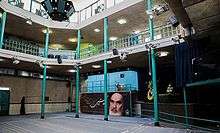Ruhollah Khomeini's residency (Jamaran)
Ruhollah Khomeini's residency is the house of Ruhollah Khomeini, the founder of the Islamic Republic of Iran, in Jamaran village. On 23 January 1980, Ayatollah Khomeini went to Tehran from Qom to cure a heart ailment. According to doctors recommendation, the weather of Qom did not agree with him. The house of Khomeini was next to the Hussainiya in Jamaran village. The house was very small and his room was 12 square meters. The house was linked to a large mosque by a metal platform.[1] Khomeini often walked up a flight of stairs leading from his house to the balcony of the mosque, from which he often spoke.[2]

Location
The Jamaran village is located in the foothills of the Alborz mountains and north of Tehran.[3] This village is near Niavaran Palace where was domicile of Mohammad Reza Pahlavi.[4]
History
.jpg)
On 23 January 1980, Ayatollah Khomeini went to Tehran from Qom to cure a heart ailment. He was hospitalized for thirty nine days, then he resided in the north Tehran suburb of Darband.[5] It was not a suitable house for him.[6] On 22 April, he took up residence in Jamaran on the suggestion of Seyyed Mahdi Imam Jamarani who was known as Imam Jamarani for leading prayers at the Jamarani mosque [3] and spent the rest of his life there.[5] The house was the birthplace of Imam Jamarani’s mother,[3] located near the mosque of Jamaran in Shaheed Husseinkiya street off Yasser Road.[7] Ayatollah Khomeini delivered speeches and met foreign delegations at Jamaran mosque.[8]
Ruhollah Khomeini's room
Ruhollah Khomeini's house was placed next to the Hussainiya in Jamaran village. The house was very small without any luxurious furnishings. His room, located in front of house, was about 12 square meters. A small platform adjoined the room to the Hussainiya where Ayatollah Khomeini gave his speeches to audiences.[9] Also, he met with Eduard Shevardnadze, first secretary of the Georgian Communist Party, and foreign minister of the Soviet Union at this room.[10]
In the news
To commemorate the death anniversary of Ayatollah Khomeini, Minister of Culture and Islamic Guidance, Ali Jannati and a number of his colleagues and artists visited Jamaran residency.[11]
Gallery
 Major Javad Fakori meets Khomeini in Jamaran
Major Javad Fakori meets Khomeini in Jamaran Jamaran Hussainiya in 2015
Jamaran Hussainiya in 2015 Ayatollah Khomeini's place
Ayatollah Khomeini's place Khomeini's room
Khomeini's room Hussainiya during anniversary of Khomeini's death
Hussainiya during anniversary of Khomeini's death
See also
- Mausoleum of Ruhollah Khomeini
- House of Leadership
- Imam khomeini Mosalla Tehran
References
- http://www.upi.com/Archives/1989/06/07/Khomeinis-home-opened-for-tour/6735613195200/
- http://content.time.com/time/magazine/article/0,9171,950688,00.html
- Camelia Entekhabifard (4 January 2011). Camelia: Save Yourself by Telling the Truth-A Memoir of Iran. Seven Stories Press. p. 27. ISBN 978-1-60980-024-6.
- Iraj Azimzadeh (1 September 2007). Tokens of God. Tokens of God. p. 210. ISBN 978-1-59584-127-8.
- Imam Khomeini: Life, Thought and Legacy. The Other Press. 2009. p. 52. ISBN 978-967-5062-25-4.
- Staff, writer. "The memories of Seyyed Mahdi Imam Jamarani". Farsnews.
- Dilip Hiro (5 September 2013). Iran Under the Ayatollahs (Routledge Revivals). Routledge. p. 263. ISBN 978-1-135-04381-0.
- Stephen Sloan; Sean K. Anderson (3 August 2009). Historical Dictionary of Terrorism. Scarecrow Press. p. 356. ISBN 978-0-8108-6311-8.
- Amirinia, Mohammad Reza (February 2013). "From Opulence to Simplicity" (PDF) (4). islam-today.
- Arshin Adib-Moghaddam (10 February 2014). A Critical Introduction to Khomeini. Cambridge University Press. p. 201. ISBN 978-1-107-72906-3.
- Staff, writer. "Iranian artists, cultural execs visit Hosseinieh Jamaran" (PDF). Tehrantimes.